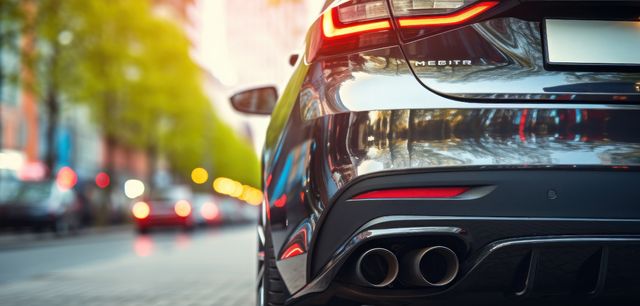11 July 2024
The EU Council adopted the new Euro 7 emission standard in April, and it came into force at the end of May. What changes will Euro 7 bring, when will the new standard apply to which types of vehicles, and to what extent does it cover electric cars for the first time in addition to petrol and diesel vehicles? We address the most important questions.
What new requirements does Euro 7 place on lorries and buses?
Euro 7 applies stricter limits for various pollutants to lorries and buses. For example, the limit values for nitrogen oxides, which can cause respiratory diseases, will be more than halved in laboratory tests from the current 460 milligrams per kilowatt hour to a maximum of 200 milligrams. A maximum of 260 milligrams is allowed for road tests. The limit values for particulate matter will be reduced from ten to eight milligrams. “Complying with these new limit values, especially in on-road testing, is going to be challenging for manufacturers, but it’s doable,” says Stephan Nentwig, Team Leader for Type Approval Commercial Vehicles at TÜV NORD Mobilität.
What has changed in the exhaust emission limits for private cars?
The emission limits for nitrogen oxides and particulate matter for private cars and light commercial vehicles have been adopted unchanged from the current Euro 6 standard. However, the limit values for particulate matter now apply to all petrol engines and not only to those engines with direct injection, as used to be the case. In the future, Euro 7 will also include smaller particles of ten nanometres as well as those measuring 23 nanometres, as is currently the case. These smaller particles occur primarily in petrol engines, especially those with direct injection, explains Helge Schmidt, exhaust emissions expert at TÜV NORD: “In this respect, petrol vehicles, which currently make up most of the passenger cars and light commercial vehicles on the road, will have to meet somewhat stricter requirements in the future.”
What other innovations does Euro 7 entail?
For the first time, Euro 7 has its sights set on total vehicle emissions: The fine dust particles from brake abrasion, and the microplastics generated from tyre wear will also be regulated in the future. The EU aims to reduce the pollution of the environment and oceans by microplastics by 30 percent by 2030. This means that vehicles that do not produce exhaust gases, i.e. fully electric cars and fuel cell vehicles, are also covered by the standard. “In this respect, Euro 7 will continue to have an effect even when no new combustion engines are registered in the EU,” Schmidt explains.
What role does brake and tyre abrasion play in particulate matter pollution?
While particulate matter emissions from exhaust gases have been significantly reduced over the past decades due to ever stricter limits and ever better exhaust gas scrubbing systems, those from brakes and tyres have remained relatively stable. This is a problem especially in urban stop-and-go traffic. “Brake particle emissions and dust from tyre abrasion will soon exceed the particulate emissions from combustion engines,” says Schmidt. “As a result, the overall reduction in particulate matter emissions in transport has flatlined, especially as the number of vehicles continues to rise. So, a regulation to cover abrasion emissions was urgently needed.”
What limit values will apply to abrasion in the future?
The test procedure and limit values for the particles from tyre abrasion are currently still being defined. The particles from brake abrasion are measured on a flywheel brake test bench (see box). When Euro 7 was introduced, the limit values still varied according to the type of drive system: A limit of three milligrams per kilometre applies to fully electric vehicles, and 7 mg/km is in force for all other types of drive. The logic behind this is that electric cars have a regenerative braking system, which means that they use the motor to brake and charge the battery in a similar way to a dynamo. As a result, much less of a toll is taken on the brake discs compared those used in combustion engines. This means that electric car brakes produce less dust and can therefore also comply with the stricter limit. From 2035, a uniform limit of 3 mg/km will apply, regardless of the type of drive.
© Adobe StockBraking and tyre wear also release particulate emissions. Euro 7 also takes this into account.
On what other levels will electric cars be covered by the new standard?
Euro 7 sets a minimum service life for electric car traction batteries. This is intended to strengthen consumer confidence and make it easier to switch to an electric vehicle. The idea is for the batteries still to have 80 percent of their original capacity after five years or 100,000 kilometres. After eight years or 160,000 kilometres, this figure should be 72 percent.
Euro 7 is also intended to provide an answer to the question of how far the various electric car models will go between charges in winter. This is because battery electrochemistry works more slowly in cold temperatures, and the interior of the vehicle also needs to be heated. This comes at the expense of range – where how much is lost depends on the vehicle. As well as the previous WLTP measurement, a low-temperature test at minus 7 degrees is therefore also set to become mandatory as part of Euro 7. “This will create transparency for consumers while also promoting technological competition among manufacturers to offer the highest possible winter ranges,” says Stephan Nentwig from TÜV NORD.
When will the new standard apply and to which types of vehicles?
Euro 7 came into force on 29 May 2024. For cars and light commercial vehicles that receive type approval for the first time, the new standard will apply 30 months after it came into force, that is from 29 November 2026. Twelve months later, that is at the end of November 2027, it will also apply to all newly registered passenger cars and light commercial vehicles. For buses and lorries, a period of four years for new type approvals and five years for all other models is envisaged for the switch to Euro 7, which means that they will have to meet the new requirements from the end of May 2028 and May 2029 respectively.
Shouldn’t the limit values for passenger cars actually be tightened by Euro 7?
In fact, the EU Commission had originally planned stricter limit values, but its proposal was significantly watered down by both the EU Parliament and the member states. The argument of member states such as France, Italy, Poland, the Czech Republic, Romania and Hungary was that, since no new combustion engines are to be registered in the EU in 2035, manufacturers will have to concentrate all their resources on the development of zero-emission vehicles. This line of argument is understandable, says emissions expert Schmidt. However, an emission standard is never set in stone for all time, says the expert. “Like Euro 5 or Euro 6, Euro 7 will continue to be developed and adapted to keep pace with changing technical developments.”
How is brake abrasion worked out?
Brake abrasion is determined on a flywheel brake test bench using a special procedure. “This is something we’ve been dealing with for a good ten years,” says emissions expert Helge Schmidt. At the TÜV NORD Institute for Automotive Technology and Mobility (IFM) in Essen, a first test bench for brake abrasion in passenger cars was recently put into operation, and another is under construction. The wheel suspension and brake are mounted in a large, closed tube. The brakes first have to be run in, as would be the case with brake discs which have been freshly changed in a workshop. During the test, the brakes are applied in a fixed cycle. The brake discs are surrounded by filtered air, i.e. air that is free of fine particulate matter. This air is captured by a kind of huge vacuum cleaner, and the brake particulate matter level in the air is then determined. “We always measure both a front and a rear brake, as the brakes are subjected to different degrees of load,” explains Stephan Nentwig from TÜV NORD.
About Stephan Nentwig:
Stephan Nentwig is team leader in the Powertrain/Emissions – Engine Dyno division at TÜV NORD Mobilität’s Institute for Vehicle Technology and Mobility (IFM) in Essen. The automotive engineer deals with the homologation and type approval of commercial vehicles for road, rail and inland waterways use.
About Helge Schmidt:
Helge Schmidt is an expert in exhaust emissions at TÜV NORD. In the TÜV Association, the graduate mechanical engineer heads the Emissions in Motor Vehicle Traffic Working Group.






